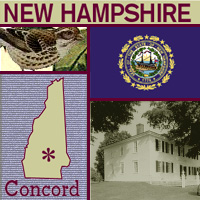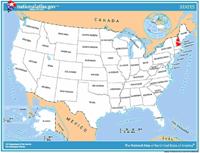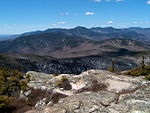|
Additional Lessons |
 About These
Lessons About These
Lessons
The following classroom lessons are great for students
who want additional listening and reading practice. |
-
Travel America -
Beginner
Level. Do you love America and American
English? Learn before you travel. Facts and other
cool stuff about your favorite U.S. state. Great
English reading practice.
|
 Travel
America - New Hampshire Travel
America - New Hampshire
(Beginner -
Reading)
Learn some interesting facts and read interesting
stories about New Hampshire. |
 New
Hampshire New
Hampshire
One of the original 13 states (it entered the Union
in 1788), New Hampshire was named after the English
county of Hampshire. New Hampshire is called the
"Granite State" because of its numerous granite
quarries; the nickname may also reflect the state's
attachment to tradition and its history of a frugal
government. There are no general sales or individual
income taxes, which fits with the state motto of
"Live free or die." A relatively small state, New
Hampshire plays a major role every four years in the
presidential election, as it holds the first primary
election. New Hampshire's state bird is the purple
finch and its capital is Concord. |
New Hampshire
State Flag
New Hampshire's state flag features the state seal
with the frigate Raleigh surrounded by laurel leaves and
nine stars against a field of blue. New Hampshire did not
officially adopt a state flag until 1909. |
|
Source:
State Symbols USA |
|
|
 New Hampshire
State Facts New Hampshire
State Facts
Picture: state seal of New Hampshire |
|
State Capital |
Concord |
|
Nickname |
Granite State |
|
Motto |
Live free or die |
|
Statehood |
June 21, 1788 (9th) |
|
Origin of Name |
Named for Hampshire, England, by Captain John Mason |
|
Largest Cities |
Manchester, Nashua, Concord, Derry, Rochester |
|
Border States |
Maine, Massachusetts, Vermont |
|
Area |
8,969 sq. mi., 44th largest |
|
State Bird |
Purple Finch |
|
State Flower |
Purple Lilac (syringa vulgaris) |
|
State Tree |
White Birch (betula papyrifera) |
|
State Song |
Old New Hampshire |
 Travel and
tourism site for New Hampshire - This state travel and
territorial tourism site provides ideas for your vacations,
meetings, and more. Travel and
tourism site for New Hampshire - This state travel and
territorial tourism site provides ideas for your vacations,
meetings, and more. |
|
|
New Hampshire Stories |
|
|
Hancock Old Home Days
Do you like picnics? The people of Hancock, New Hampshire, like them
so much that what started as a family picnic in 1879 has grown into
a picnic that includes the whole town and anyone who has ever lived
there!
Hancock has celebrated Old Home Day for more than 120 years. The
celebration includes the Hancock Town Picnic and a parade. In 1999,
the Old Home Day parade included a Y2K Bug float! Townspeople see
the gathering as a way to encourage others who have moved away to
come back and visit. Apparently, other people in the state thought
it was a good idea as well. Today, invitations are sent out across
the country to relatives and New Hampshire descendants to return for
the statewide celebration. In 1899, New Hampshire Governor Frank
Rollins made Old Home Day a state holiday. |
|
|
Amoskeag Millyard
What's a "company town"? In case you're not sure, the story of the
Amoskeag Manufacturing Company in Manchester, New Hampshire, is a
good example of one.
At the beginning of the 20th century, the Amoskeag Manufacturing
Company was the largest maker of cotton cloth in the world. It
employed most of the town's people and became so powerful that it
even played a big role in city planning. No other manufacturing
companies could think about locating in New Hampshire without
Amoskeag's permission, because it owned most of the land available
for industry.
At first, only young women worked at the Amoskeag mills. After the
Civil War, men were also hired, as were many immigrants. The mill
brought great prosperity to the city. But that prosperity did not
last forever.
After the First World War, many textile mills were located in the
South, which was closer to the cotton farms and where wages were
lower. Eventually, the Amoskeag Company had to lower wages to stay
in business, causing the workers to strike in 1922. The company
reopened, but it was not as strong as before. In 1935, it closed
forever, bringing economic disaster to the town and its people. |
|
|
Strawbery Banke
Have you ever been in a house that's older than the United States?
If you go to Strawbery Banke, a historic area in Portsmouth, New
Hampshire, you can see this 300-year-old house plus a lot of other
very old buildings. Strawbery Banke is an outdoor museum of historic
buildings. They are being preserved because they help us learn how
people lived hundreds of years ago.
One of the buildings in Strawbery Banke is Sherburne House, which
was built in 1695 by Captain John Sherburne. The architecture of the
house (the way it's built) tells us that the early European settlers
of Portsmouth were English. On the ceiling in one of the rooms are
brightly colored spots that had been sponge-painted. The spots make
the room look more cheerful. We tend to think of the early settlers
as being very serious. Perhaps this simple decoration -- bright
ceiling spots - lets us see them as more good-natured than we
thought and, maybe, even more like ourselves. |
|
|
Danbury Grange and Community Fair
How much pie can you eat in a single sitting? The Blazing Star
Grange Number 71 in Danbury, New Hampshire, has a pie-eating contest
as part of its community fair, which has been held annually since
1914.
Do you know what a Grange is? It is a family-oriented, social
organization that focuses on agriculture and rural life and was
founded by farmers in the 19th century. The word comes from "grain."
There are local granges all over the country. Today, granges are
involved in community service projects such as raising money for
charities and increasing public awareness of local issues. The
Blazing Star Grange community fair also includes live music,
auctions, a parade -- and a lot of pies.
Not everyone in Danbury gets excited about the community fair
parade. One year, two huge oxen, Ike and Mike, were a part of the
parade. After a while, they decided they had had enough, so they
simply turned off the street and went straight home. Ike and Mike
didn't want any part of the parade -- they just wanted their barn
and their hay! |
|
|
Thompson School of Applied Science
The Thompson School of Applied Science, in Durham, is part of the
University of New Hampshire. It's a school for people who want to
work with animals, forests or farms.
One of the departments in the school is the Applied Animal Science
Department. Since so many Americans have dogs, cats, and other small
animals, it's important to have people who are trained to care for
these animals. Students at the Thompson School can study Small
Animal Care. This is the study of how pets behave and how to train
and groom them. Students also learn what kinds of food dogs and cats
should eat and how to keep them healthy. Many go on to work with
veterinarians or humane societies or become pet groomers.
The two other areas in Applied Animal Science are Equine Management
and Dairy Management. Equine Management teaches all sorts of
subjects related to horses - everything from riding to physical care
of the animals to management of barns and stables. In the Dairy
Management program students experience practical, hands-on work with
cattle as well as learning about the business of farming. Have you
ever considered a career with animals? |
|
|
Peace Treaties in Portsmouth
Two peace treaties have been signed in Portsmouth, New Hampshire.
One was signed before America gained its independence from the
British and the other was signed almost 200 years later. Do you know
the treaties?
From 1702 to 1713, Great Britain and France fought in the West
Indies and in the Carolina and New England frontiers in Queen Anne's
War. At the end of the war, the American Indians who had sided with
the French surrendered to the British. On July 13, 1713,
representatives from the Indian tribes, Massachusetts Bay, and New
Hampshire met in Portsmouth to sign a treaty. The Indians agreed not
to fight the British anymore. This treaty is interesting in part
because the Indian representatives signed their names in three
languages: French, English, and their own, which is in pictograph,
or drawn symbols.
Almost 200 years later, in 1905, President Theodore Roosevelt held a
peace conference in Portsmouth to help end the Russo-Japanese War.
As a result, Japan and Russia signed the Treaty of Portsmouth.
President Roosevelt received the Nobel Peace Prize for his efforts. |
|
|
Northern Forest Heritage Park
There's plenty to do besides camping in White Mountain National
Forest, such as fishing, hiking, spying on moose, and skiing. But
it's also a good place to learn about local history. Within this New
Hampshire National Forest is the Northern Forest Heritage Park. The
park has a museum and other buildings that tell visitors about the
local logging industry. In fact, Northern Forest Heritage Park runs
the oldest continuous logging operation in the United States.
Considered a "working forest," the Northern Forest Heritage Park is
located along the Androscoggin River. This was a major area in the
logging and paper industry in the mid-19th and early-20th centuries.
The Northern Forest offered a large supply of trees, and the
Androscoggin River provided water power for the sawmills. Immigrants
from many countries including Norway, Russia, Ireland, and Italy
worked in the mills. As a result, the area boomed and several
companies were established to take advantage of the wood and paper
industries. At the same time, efforts were made to keep a forest
growing, including the establishment of the first industrial
forestry program in the nation.
Next time you are in a forest, think about all the things you can do
there, as well as all the natural resources around you. |
|
Source:
Library of Congress |
|
 National
Forests of New
Hampshire National
Forests of New
Hampshire
The following is a description of national
forests in the state
of New Hampshire. There are no national
parks or monuments in this state. If you plan to visit or
live in New Hampshire for awhile then you
should definitely plan to visit some of
these fantastic places. |
|
|
|
National Forests |
 White
Mountain White
Mountain
This National Forest is located in the White
Mountains, which the Appalachian Trail and
White Mountain Scenic Byway pass through.
The forest includes Mount Washington, which
at 6,288 ft (1,917 m) is the highest point
in the Northeast and the location of the
fastest wind speed recorded on earth,
although the summit is located in a state
park. This national forest is also partially
located in the state of Maine. |
|
|
|
 Travel
America Travel
America
Do you love America and American English? Learn before
you travel. Facts and other cool stuff about your
favorite U.S. state. Visit the Fun Easy English Travel
America pages. Read about the beautiful National
Forests, Parks, and Monuments. Great English reading practice. |
 Drive America Drive America
Planning to drive in America? Learn the rules and
regulations. Great English reading practice. |
|